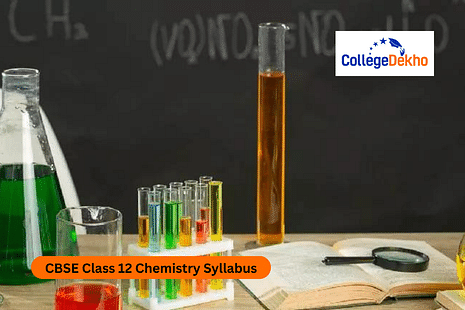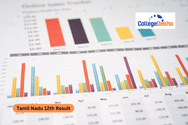- CBSE Class 12 Chemistry Syllabus 2025: Chapter-Wise
- CBSE Class 12 Chemistry Syllabus 2025 For Practicals
- CBSE Class 12th Chemistry Syllabus 2025- Download PDF
- CBSE Class 12 Chemistry Exam Pattern 2025
- CBSE Class 12 Chemistry Syllabus 2025: Project Work
- CBSE Class 12 Chemistry Deleted Syllabus 2025
- CBSE Class 12 Chemistry Syllabus 2025: Question Paper Pattern
- CBSE Class 12 Chemistry Syllabus 2025: Prescribed Books
- Faqs


Never Miss an Exam Update
CBSE Class 12 Chemistry Syllabus 2025 is available on the official website, at cbseacademic.nic.in. There are two parts in NCERT Chemistry Class 12 Syllabus: Organic and Inorganic Chemistry. The Chemistry syllabus comprises a total of 10 chapters, where 5 chapters will be from organic chemistry, and the other 5 chapters will be from the inorganic chemistry portion. Unit 2, Electrochemistry carries the maximum weightage of 9 marks. Other than that, the weightage of the syllabus is uniformly distributed. CBSE Class 12 Board 2025 has decided to retain the Class 12 Chemistry Deleted Syllabus where surface chemistry, polymers, p-block elements, and more remain deleted. Moreover, the changed name of the chapter Organic Compounds Containing Nitrogen is Amines. CBSE class 12th Chemistry theory exam will be conducted for 70 marks and 30 marks will be allocated for the practical exam. Read the complete article to know more about the CBSE Class 12 Chemistry Syllabus 2025.
The CBSE Class 12th Chemistry Syllabus 2025 consists of the course structure, unit-wise mark distribution, evaluation scheme for practical examinations, practical experiments, etc. Students can also check the steps to download the CBSE Class 12th Chemistry Syllabus 2025 from here.
Also Read: CBSE Class 12 Chemistry Important Questions 2025
CBSE Class 12 Chemistry Syllabus 2025: Chapter-Wise
The chapter-wise and topic-wise syllabus has been discussed below:
Unit II: Solutions [10 Periods]
Types of solutions, expression of concentration of solutions of solids in liquids, solubility of gases in liquids, solid solutions, Raoult's law, colligative properties - relative lowering of vapour pressure, elevation of boiling point, depression of freezing point, osmotic pressure, determination of molecular masses using colligative properties, abnormal molecular mass, Van't Hoff factor.
Unit III: Electrochemistry [12 Periods]
Redox reactions, EMF of a cell, standard electrode potential, Nernst equation and its application to chemical cells, Relation between Gibbs energy change and EMF of a cell, conductance in electrolytic solutions, specific and molar conductivity, variations of conductivity with concentration, Kohlrausch's Law, electrolysis and law of electrolysis (elementary idea), dry cell-electrolytic cells and Galvanic cells, lead accumulator, fuel cells, corrosion.
Unit IV: Chemical Kinetics [10 Periods]
Rate of a reaction (Average and instantaneous), factors affecting rate of reaction: concentration, temperature, catalyst; order and molecularity of a reaction, rate law and specific rate constant, integrated rate equations and half-life (only for zero and first order reactions), concept of collision theory (elementary idea, no mathematical treatment), activation energy, Arrhenius equation.
Unit VIII: d and f Block Elements [12 Periods]
General introduction, electronic configuration, occurrence and characteristics of transition metals, general trends in properties of the first-row transition metals – metallic character, ionization enthalpy, oxidation states, ionic radii, colour, catalytic property, magnetic properties, interstitial compounds, alloy formation, preparation and properties of K 2 Cr 2 O 7 and KMnO 4 .
- Lanthanoids: Electronic configuration, oxidation states, chemical reactivity and lanthanoid contraction and its consequences.
- Actinoids: Electronic configuration, oxidation states, and comparison with lanthanoids.
Unit IX: Coordination Compounds [12 Periods]
Coordination compounds: Introduction, ligands, coordination number, colour, magnetic properties and shapes, IUPAC nomenclature of mononuclear coordination compounds. Bonding, Werner's theory, VBT, and CFT; structure and stereoisomerism, importance of coordination compounds (in qualitative analysis, extraction of metals and biological system).
Unit X: Haloalkanes and Haloarenes [10 Periods]
- Haloalkanes: Nomenclature, nature of C–X bond, physical and chemical properties, optical rotation mechanism of substitution reactions.
- Haloarenes: Nature of C–X bond, substitution reactions (Directive influence of halogen in monosubstituted compounds only). Uses and environmental effects of - dichloromethane, trichloromethane, tetrachloromethane, iodoform, freons, DDT.
Unit XI: Alcohols, Phenols, and Ethers [10 Periods]
- Alcohols: Nomenclature, methods of preparation, physical and chemical properties (of primary alcohols only), identification of primary, secondary and tertiary alcohols, mechanism of dehydration, uses with special reference to methanol and ethanol.
- Phenols: Nomenclature, methods of preparation, physical and chemical properties, acidic nature of phenol, electrophilic substitution reactions, uses of phenols.
- Ethers: Nomenclature, methods of preparation, physical and chemical properties, uses.
Unit XII: Aldehydes, Ketones and Carboxylic Acids [10 Periods]
- Aldehydes and Ketones: Nomenclature, nature of carbonyl group, methods of preparation, physical and chemical properties, mechanism of nucleophilic addition, reactivity of alpha hydrogen in aldehydes, uses.
- Carboxylic Acids: Nomenclature, acidic nature, methods of preparation, physical and chemical properties; uses.
Unit XIII: Amines [10 Periods]
- Amines: Nomenclature, classification, structure, methods of preparation, physical and chemical properties, uses, and identification of primary, secondary and tertiary amines.
- Diazonium salts: Preparation, chemical reactions and importance in synthetic organic chemistry.
Unit XIV: Biomolecules [12 Periods]
- Carbohydrates: Classification (aldoses and ketoses), monosaccharides (glucose and fructose), D-L configuration oligosaccharides (sucrose, lactose, maltose), polysaccharides (starch, cellulose, glycogen); Importance of carbohydrates.
- Proteins: Elementary idea of - amino acids, peptide bonds, polypeptides, proteins, structure of proteins - primary, secondary, tertiary structure and quaternary structures (qualitative idea only), denaturation of proteins; enzymes. Hormones - Elementary idea excluding structure.
- Vitamins: Classification and functions.
- Nucleic Acids: DNA and RNA.
CBSE Class 12 Chemistry Syllabus 2025 For Practicals
Go through the topic-wise CBSE class 12 Chemistry syllabus 2025:
Surface Chemistry(a) Preparation of one lyophilic and one lyophobic sol
- Lyophilic sol-starch, egg albumin and gum
- Lyophobic sol - aluminium hydroxide, ferric hydroxide, arsenous sulphide.
(b) Dialysis of sol-prepared in (a) above.
(c) Study of the role of emulsifying agents in stabilizing the emulsion of different oils.
Chemical Kinetics(a) Effect of concentration and temperature on the rate of reaction between Sodium Thiosulphate and Hydrochloric acid.
(b) Study of reaction rates of any one of the following:
- Reaction of Iodide ion with Hydrogen Peroxide at room temperature using different concentrations of Iodide ions.
- Reaction between Potassium Iodate, (KIO 3 ) and Sodium Sulphite: (Na 2 SO 3 ) using starch solution as indicator (clock reaction).
Any one of the following experiments
- i) Enthalpy of dissolution of Copper Sulphate or Potassium Nitrate.
- ii) Enthalpy of neutralization of strong acid (HCl) and strong base (NaOH).
iii) Determination of enthalpy change during interaction (Hydrogen bond formation) between Acetone and Chloroform.
Electrochemistryi) Variation of cell potential in Zn/Zn 2+ || Cu 2+ /Cu with change in concentration of electrolytes (CuSO 4 or ZnSO 4 ) at room temperature.
Chromatography
i) Separation of pigments from extracts of leaves and flowers by paper chromatography and determination of Rf values.
ii) Separation of constituents present in an inorganic mixture containing two cations only (constituents having large differences in Rf values to be provided).
Preparation of Inorganic Compounds
i) Preparation of double salt of Ferrous Ammonium Sulphate or Potash Alum. Preparation of Potassium Ferric Oxalate.
Preparation of Organic Compounds
Preparation of any one of the following compounds
i) Acetanilideii) Di -benzalAcetone
iii) p-Nitroacetanilide
iv) Aniline yellow or 2 - Naphthol Aniline dye.
Tests for the functional groups present in organic compounds:
Unsaturation, alcoholic, phenolic, aldehydic, ketonic, carboxylic, and amino (Primary) groups.
Characteristic tests of carbohydrates, fats and proteins in pure samples and their detection in given foodstuffs.Determination of concentration/ molarity of KMnO4 solution by titrating it against a standard solution of:
i) Oxalic acid,
ii) Ferrous Ammonium Sulphate (Students will be required to prepare standard solutions by weighing themselves).
Qualitative analysis
Determination of one cation and one anion in a given salt. Cation : Pb 2+ , Cu 2+ As3 + , Aℓ 3+ , Fe 3+ , Mn 2+ , Zn 2+ , Cu 2+ , Ni 2+ , Ca 2+ , Sr 2+ , Ba 2 +, Mg 2+ , NH 4+ Anions: (CO 2 ) 2- , S 2- , (SO 3 ) 2- , (NO 2 ) - , (SO 4 ) 2- , Cℓ - , Br - , I - , PO 3- 4, (C 2 O 4 ) 2- , CH 3 COO - ,NO 3 -
(Note: Insoluble salts excluded)
CBSE Class 12th Chemistry Syllabus 2025- Download PDF
The CBSE Class 12 Chemistry syllabus for 2025 is divided into two components: theory and internal evaluation. The theory exam carries 70 marks, while the internal assessment is allotted 30 marks. The syllabus includes ten units for the theory exam and eleven chapters for the practical component, with detailed subtopics for each chapter. Students can access the syllabus in PDF format to aid their preparation for the board exams.
| Particulars | Download PDF |
|---|---|
| cbse 12th Chemistry Syllabus | Download Now |
CBSE Class 12 Chemistry Exam Pattern 2025
Students can go through the CBSE Class 12 Exam Pattern 2025 when preparing for the class 12 Chemistry exam. This gives them a good idea of the importance of questions. They can prepare various types of questions according to the marks allotted by the board. Students will easily be able to attempt the questions of difficulty level in the best manner.
Section | Type of Question | No of Questions | Total Marks |
|---|---|---|---|
A | Multiple-Choice Questions (MCQs)/ Assertion-Reasoning | 16 | 1 x 16 = 16 |
B | Short Answer Questions | 5 | 2 x 5 = 10 |
C | Short Answer Questions | 7 | 3 x 7 = 21 |
D | Case-based Questions | 2 | 4 x 2 = 8 |
E | Long Answer Questions | 3 | 5 x 3 = 15 |
CBSE Class 12 Chemistry Marking Scheme 2025
Given below, we have shared the basic information about the weightage of each topic according to the latest CBSE Class 12 Chemistry Syllabus 2025:
| Chapter | Marks |
|---|---|
| Solutions | 7 |
| Electrochemistry | 9 |
| Chemical Kinetics | 7 |
| d and f block elements | 7 |
| Coordination Compounds | 7 |
| Haloalkakenes and Haloarenes | 6 |
| Alcohols, Phenols, and Ethers | 6 |
| Aldehydes, Ketones and Carboxylic Acid | 8 |
| Amines | 6 |
| Biomolecules | 7 |
| Total | 70 |
CBSE Class 12 Chemistry Marking Scheme for Practicals
Students can refer to the updated information about the detailed CBSE Class 12 Chemistry Syllabus 2025 for Practicals from the table given below:
| Topics | Marks |
|---|---|
| Volumetric Analysis | 8 |
| Salt Analysis | 8 |
| Content-Based Experiment | 6 |
| Project Work | 4 |
| Class record and viva | 4 |
| Total | 30 |
CBSE Class 12 Chemistry Syllabus 2025: Project Work
Some of the few suggested project works for CBSE class 12th Chemistry syllabus 2025 that students will have to perform are as follows:
- Study of the presence of oxalate ions in guava fruit at different stages of ripening.
- Study of quantity of casein present in different samples of milk.
- Preparation of soybean milk and its comparison with natural milk concerning curd formation, the effect of temperature, etc.
- Study of the effect of Potassium Bisulphate as a food preservative under various conditions (temperature, concentration, time, etc.)
- Study of digestion of starch by salivary amylase and effect of pH and temperature on it. Comparative study of the rate of fermentation of the following materials: wheat flour, gram flour, potato juice, carrot juice, etc.
- Extraction of essential oils present in Saunf (aniseed), Ajwain (carum), and Illaichi (cardamom). Study of common food adulterants in fat, oil, butter, sugar, turmeric powder, chilli powder, and pepper.
Note: Students can choose any other investigatory project, which involves about 10 periods of work, with the approval of the teacher.
CBSE Class 12 Chemistry Deleted Syllabus 2025
The board has removed certain chapters from the CBSE Class 12th Chemistry syllabus. The table below includes the details of CBSE Class 12 Chemistry Deleted Syllabus 2025 .
Chemistry Part 1 | ||
|---|---|---|
Units | Page No. | Dropped Topics/Chapters |
Unit 1: The Solid State | 1–34 | Full Chapter |
Unit 5: Surface Chemistry | 123–148 | Full Chapter |
Unit 6: General Principles and Processes of Isolation of Elements | 149–169 | Full Chapter |
Unit 7: The p-Block Elements | 170–214 | Full Chapter |
Chemistry Part 2 | ||
Unit 15: Polymers | 433–446 | Full Chapter |
Unit 16: Chemistry in Everyday Life | 447–463 | Full Chapter |
CBSE Class 12 Chemistry Syllabus 2025: Question Paper Pattern
CBSE Class 12 Chemistry Sample Paper 2025 is divided into two sections: Section A will carry 20 marks, while Section B will be for 50 marks. Section A comprises 5 one-mark questions, Section B has 10 two-mark questions, 10 three-mark questions, and 5 five-mark questions. Check the pattern here:
S. No. | Types of Questions | Approx Percentage | Total Marks |
|---|---|---|---|
1 | Remembering and Understanding | 40% | 28 |
2 | Applying | 30% | 21 |
3 | Analyzing, Evaluating, and Creating | 30% | 21 |
Total | 70 |
CBSE Class 12 Chemistry Syllabus 2025: Prescribed Books
CBSE Board strictly follows NCERT and its class 12th Chemistry syllabus. Therefore, the NCERT books are the best solution for the students who are appearing for the upcoming CBSE class 12 Chemistry exam. Apart from this, for a better understanding of the concepts, students can refer to the Best Reference Books for CBSE Class 12 here:
Name of the Books | Writer Names |
|---|---|
Pradeep’s New Course Chemistry Class XII (Vol. I and II) | S.C. Kheterpal, S.N. Dhawan, P.N. Kapil |
Modern’s ABC of Chemistry Class 12 (Part 1 and 2) | S.P. Jauhar |
Modern Approach to Chemical Calculations | R.C. Mukherjee |
CBSE Chapterwise Solutions Chemistry Class 12 | Purnima Sharma |
SP Chemistry Class XII | OP Tandon, A.K. Virmani, A.S. Singh |
CBSE Class 12 Chemistry Syllabus 2025 is very helpful for the people who will be appearing for class 12th board exams. You can check out the major information about the syllabus from the article provided above and prepare yourself accordingly. Make sure to refer to the latest syllabus and prepare yourself accordingly.
FAQs
There are a total of 10 chapters in the CBSE class 12 Chemistry Syllabus for the academic session 2024-25.
The CBSE class 12th Chemistry exam 2025 will be conducted for 100 marks, where 70 marks will be allotted for the theory portion, and the remaining 30 marks will be for the practical exams.
You can find the CBSE class 12 Chemistry Syllabus 2024-25 on the CBSE Board’s official website at cbseacademic.nic.in. You can also access the detailed syllabus from this page.
In the CBSE Class 12 Chemistry Syllabus 2025, the maximum weightage carrying chapter is Electrochemistry. This unit will be carrying a total of 09 marks.
The CBSE class 12 Chemistry syllabus 2025 is uniformly distributed against the chapters. For more information, check the detailed marking scheme of the syllabus above on this page.
The deleted chapters in CBSE class 12th Chemistry syllabus 2025 are Surface Chemistry, General Principles, and Processes of Isolation of Elements, p -Block Elements, Polymers, and Organic compounds containing Nitrogen.
The CBSE class 12 Chemistry theory exam paper 2025 is divided into two parts: Section A and Section B. Section A which will carry 20 marks will comprise 5 one-mark questions, whereas Section B which will carry 50 marks, will have 10 two-mark questions, 10 three-mark questions, and 5 five-mark questions.
Was this article helpful?

























